Adaptive Complex Variational Mode Decomposition for Micro-Motion Signal Processing Applications
Abstract
:1. Introduction
2. Brief Description of Variational Mode Decomposition
- (1)
- Firstly, the original signal is transformed by Hilbert transform to obtain the analytic signal of each mode component, and the single side spectrum is obtained.
- (2)
- The center frequency of each modal component is estimated and the spectrum is modulated to the corresponding baseband.
- (3)
- The square of the norm of the gradient of the modulated signal and the bandwidth of each mode component is estimated. The constrained variational mode is constructed, which is described by the following equation:
- (4)
- By introducing the balancing parameter of the data-fidelity constraint with great convergence property and the Lagrange multiplier with strict constraint performance, the constrained optimization problem is transformed into an unconstrained optimization problem, and the augmented Lagrange expression can be written as follows:
- (5)
- The iterative update of and in the frequency domain.
3. Complex Variational Mode Decomposition
- (1)
- The complex signal can be transformed into frequency domain by Fourier transform, which is recorded as . By setting the negative frequency axis or positive frequency axis of to zero respectively, the positive frequency part and negative frequency part of are taken out, and the signal length cannot be changed, written as:
- (2)
- After inverse Fourier transform of and , the corresponding time domain signals and can be obtained to decompose, this is because both and are real signals at this moment. Besides, since the signal length is not changed during spectrum processing, the corresponding time domain signals and have the same length as the original signal .
- (3)
- VMD is used to decompose and to get the corresponding BLIMF components and . Since and only contain positive frequency, if the inverse Fourier transform were applied to BLIMF component directly, the reconstructed signal would still contain positive frequency, which is inconsistent with the real situation. This is caused by making . Therefore, in order to ensure that the reconstructed signal is consistent with the original signal, it is necessary to carry out reverse order rearrangement to signal , namely:
4. Adaptive Complex Variational Mode Decomposition
4.1. Solution of Optimal Decomposition Layer K
- (1)
- Constructing the Hank matrix [27] by using the signal .
- (2)
- Implement the SVD processing on to obtain the singular values and the slope of the singular value.
- (3)
- Setting the amplitude ratio threshold to search the steady-state starting position of the slope, that is the effective singular value order.
4.2. Principle of Signal Reconstruction
5. Results and Discussions
5.1. Analysis of Experimental Data
5.2. Analysis of Measured Data
6. Conclusions
- (1)
- The positive spectrum and negative spectrum were obtained by dividing the spectrum of the complex signal. The negative spectrum after reverse processing and positive spectrum were converted into time domain and sent to VMD for processing. All the decomposed modes were linearly superimposed to restore the original complex signal and realize CVMD processing of complex signal, but the computational complexity was doubled.
- (2)
- The SVD was used to get the singular value vector of the decomposed signal. By setting the amplitude ratio threshold on the singular value slope curve, the effective singular value order can be obtained as the decomposition layer of CVMD. Under this decomposition layer, the CVMD decomposition result did not appear as under-decomposition or over-decomposition phenomenon, which shows that the effective singular value order of SVD is consistent with the optimal decomposition layer of CVMD.
- (3)
- Mahalanobis distance can robustly judge the correlation between each mode and the original signal and can effectively highlight the strong correlation mode. By selecting the strong correlation mode to reconstruct the signal, it can achieve the separation of the micro-motion signal.
Author Contributions
Funding
Institutional Review Board Statement
Informed Consent Statement
Data Availability Statement
Conflicts of Interest
References
- Chen, V.; Li, F.; Ho, S.-S.; Wechsler, H. Analysis of micro-Doppler signatures. IEE Proc. Radar Sonar Navig. 2003, 150, 271. [Google Scholar] [CrossRef]
- Chen, V. Doppler signatures of radar backscattering from objects with micro-motions. IET Signal Process. 2008, 2, 291. [Google Scholar] [CrossRef]
- Chen, V.C. The Micro-doppler effect in radar. Artech House 2011, 3, 105–127. [Google Scholar]
- Chen, V.C.; Tahmoush, D.; Miceli, W.J. Radar Micro-Doppler Signature Processing and Applications. Inst. Eng. Technol. 2014, 4, 187–227. [Google Scholar]
- Zheng, L.; Yao, W.W.; Yang, C. Clutter Suppression Method for Short Range Slow Moving Target Detection. J. Electron. Inf. Technol. 2018, 40, 2506–2512. [Google Scholar]
- Abujarad, F.; Nadim, G.; Omar, A. Clutter reduction and detection of landmine objects in ground penetrating radar data using singular value decomposition. In Proceedings of the 3rd International Workshop on Advanced Ground Penetrating Radar, Delft, The Netherlands, 2–3 May 2005. [Google Scholar]
- Hervé, A.; Williams, L.J. Principal component analysis. Wiley Interdiplinary Rev. Comput. Stat. 2010, 2, 433–459. [Google Scholar]
- Comon, P. Independent component analysis, a new concept? Signal Process. 1994, 36, 287–314. [Google Scholar] [CrossRef]
- Verma, P.K.; Gaikwad, A.N.; Singh, D.; Nigam, M.J. Analysis of clutter reduction techniques for through wall imaging in uwb range. Prog. Electromagn. Res. B 2009, 17, 29–48. [Google Scholar] [CrossRef] [Green Version]
- Tivive, F.H.C.; Bouzerdoum, A.; Amin, M.G. A Subspace Projection Approach for Wall Clutter Mitigation in Through-the-Wall Radar Imaging. IEEE Trans. Geosci. Remote. Sens. 2015, 53, 2108–2122. [Google Scholar] [CrossRef] [Green Version]
- Tang, H.; Wan, X.; Ke, H. Signal Detection in Clutter and Noise Using Well-Characterized Subspace. IEEE Signal Process. Lett. 2017, 24, 1343–1347. [Google Scholar] [CrossRef]
- Huang, N.E.; Shen, Z.; Long, S.R.; Wu, M.C.; Shih, H.H.; Zheng, Q.; Yen, N.-C.; Tung, C.C.; Liu, H.H. The empirical mode decomposition and the Hilbert spectrum for nonlinear and non-stationary time series analysis. Proc. R. Soc. A Math. Phys. Eng. Sci. 1998, 454, 903–995. [Google Scholar] [CrossRef]
- Lin, L.; Hong, B.J. Signal feature extraction based on an improved EMD method. Measurement 2009, 42, 796–803. [Google Scholar] [CrossRef]
- Alejandro, B.; Higinio, R.; Castejón, C. EMD-Based Methodology for the Identification of a High-Speed Train Running in a Gear Operating State. Sensors 2018, 18, 793. [Google Scholar]
- Jonathan, S. The local mean decomposition and its application to EEG perception data. J. R. Soc. Interface 2005, 2, 443–454. [Google Scholar]
- Jiang, W.L.; Zhu, Y.; Yang, K. Gear fault diagnosis method based on local mean decomposition and generalized morphologi-cal fractal dimensions. Mech. Mach. Theory 2015, 91, 151–167. [Google Scholar]
- Liu, H.; Han, M. A fault diagnosis method based on local mean decomposition and multi-scale entropy for roller bearings. Mech. Mach. Theory 2014, 75, 67–78. [Google Scholar] [CrossRef]
- Dragomiretskiy, K.; Zosso, D. Variational Mode Decomposition. IEEE Trans. Signal Process. 2014, 62, 531–544. [Google Scholar] [CrossRef]
- Wang, Y.X.; Jiang, S.L. Complex variational mode decomposition for signal processing applications. Mech. Syst. Signal Process. 2017, 86, 75–85. [Google Scholar] [CrossRef]
- Liu, W.; Cao, S.; Chen, Y. Applications of variational mode decomposition in seismic time-frequency analysis. Geophysics 2016, 81, V365–V378. [Google Scholar] [CrossRef]
- Lahmiri, S.; Boukadoum, M. Biomedical image denoising using variational mode decomposition. In Proceedings of the 2014 IEEE Biomedical Circuits and Systems Conference (BioCAS) Proceedings, Lausanne, Switzerland, 22–24 October 2014; pp. 340–343. [Google Scholar]
- Liu, Y.; Yang, G.; Li, M.; Yin, H. Variational mode decomposition denoising combined the detrended fluctuation analysis. Signal Process. 2016, 125, 349–364. [Google Scholar] [CrossRef]
- Zhao, Z.J.; Huang, Y.B.; Qiang, F.F. Single channel blind source separation algorithm based on feedback variational mode decomposition. J. Vib. Shock 2019, 38, 261–267. [Google Scholar]
- Wang, F.T.; Liu, C.X.; Zhang, T. Fault Diagnosis of Rolling Bearing Based on k-Optimized VMD. J. Vib. Meas. Diagn. 2018, 38, 540–547. [Google Scholar]
- Luo, Y.Y.; Yao, Y.B.; Huang, C. Deformation Feature Extraction and Analysis Based on Improved Variational Mode Decom-position. Geomat. Inf. Sci. Wuhan Univ. 2020, 45, 612–619. [Google Scholar]
- Yang, W.; Peng, Z.; Wei, K.; Shi, P.; Tian, W. Superiorities of variational mode decomposition over empirical mode decomposition particularly in time–frequency feature extraction and wind turbine condition monitoring. IET Renew. Power Gener. 2017, 11, 443–452. [Google Scholar] [CrossRef] [Green Version]
- Gres, S.; Ulriksen, M.D.; Döhler, M.; Johansen, R.J.; Andersen, P.; Damkilde, L.; Nielsen, S.A. Statistical methods for damage detection applied to civil structures. Procedia Eng. 2017, 199, 1919–1924. [Google Scholar] [CrossRef]
- Zhang, M.; Jiang, Z.; Feng, K. Research on variational mode decomposition in rolling bearings fault diagnosis of the multi-stage centrifugal pump. Mech. Syst. Signal Process. 2017, 93, 460–493. [Google Scholar] [CrossRef] [Green Version]
- Xie, H.-B.; He, W.-X.; Liu, H. Measuring time series regularity using nonlinear similarity-based sample entropy. Phys. Lett. A 2008, 372, 7140–7146. [Google Scholar] [CrossRef]
- Xia, S.Q.; Xiang, H.; Chen, W.F. Clutter suppression for micromotion target based on CEMD. Acta Aeronaut. et Astronaut. Sin. 2018, 39, 322082. [Google Scholar]
- Ren, G.; Jia, J.; Mei, J. Variational mode decomposition denoising combined with the Euclidean distance for diesel engine vi-bration signal. J. Vibroeng. 2018, 20, 2045–2059. [Google Scholar]
- Ma, W.; Yin, S.; Jiang, C.; Zhang, Y. Variational mode decomposition denoising combined with the Hausdorff distance. Rev. Sci. Instrum. 2017, 88, 035109. [Google Scholar] [CrossRef]
- Mahalanobis, P.C. On the generalised distance in statistics. Proc. Natl. Inst. Sci. India. 1936, 2, 49–55. [Google Scholar]
- Chen, Y.B.; Li, S.D.; Yang, J. Rotor blades radar echo modeling and its mechanism analysis. Acta Phys. Sinica 2016, 65, 138401. [Google Scholar] [CrossRef]
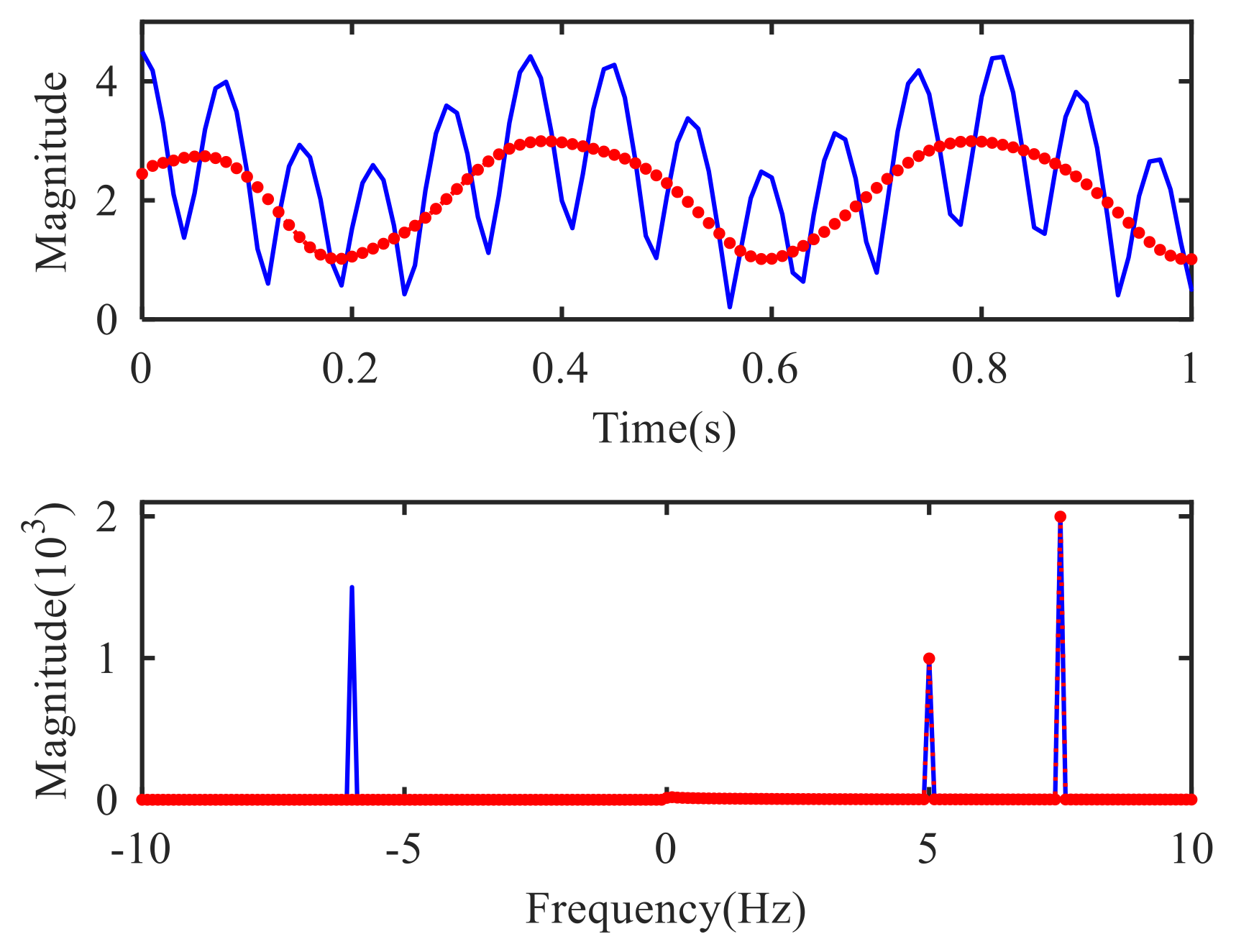
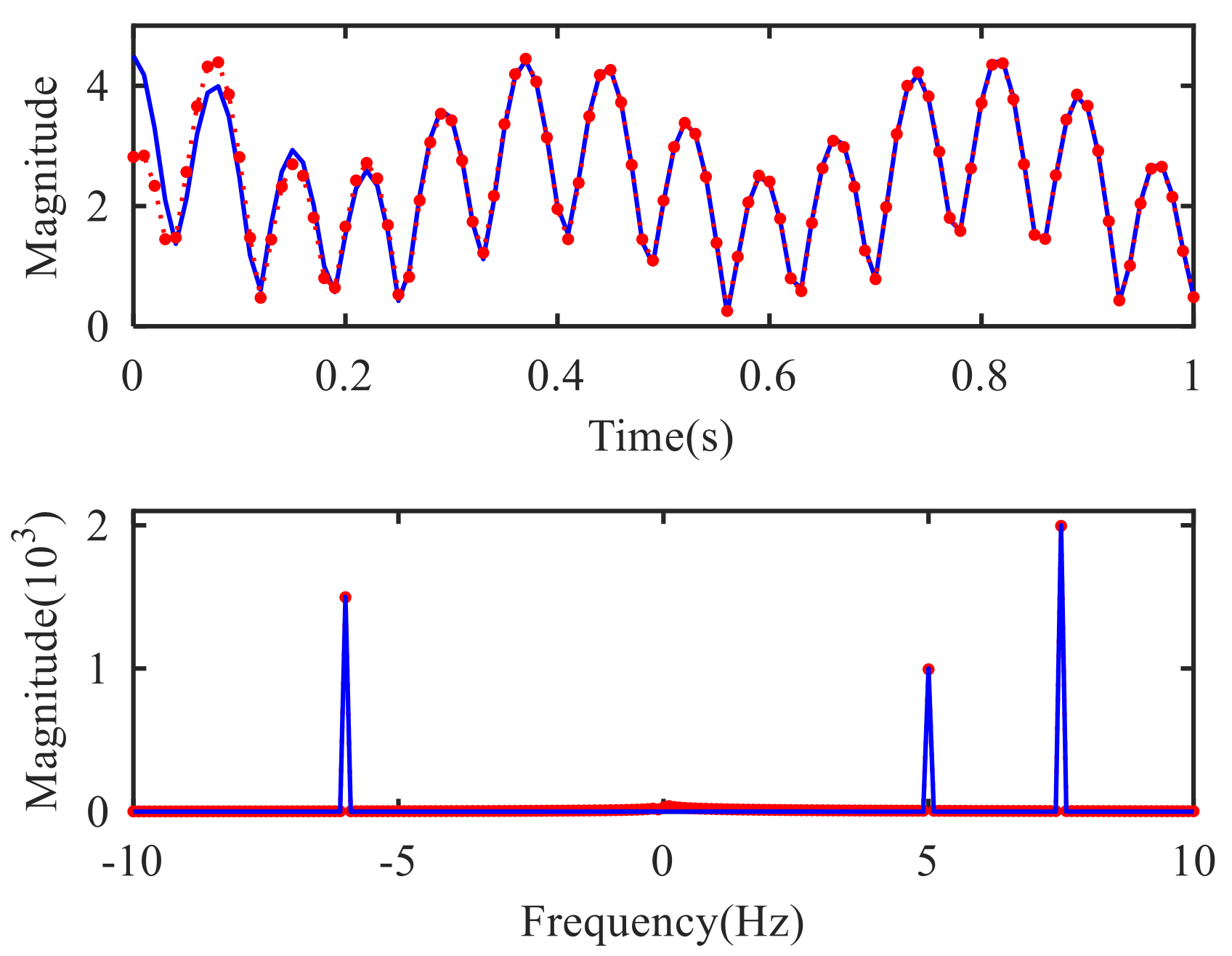
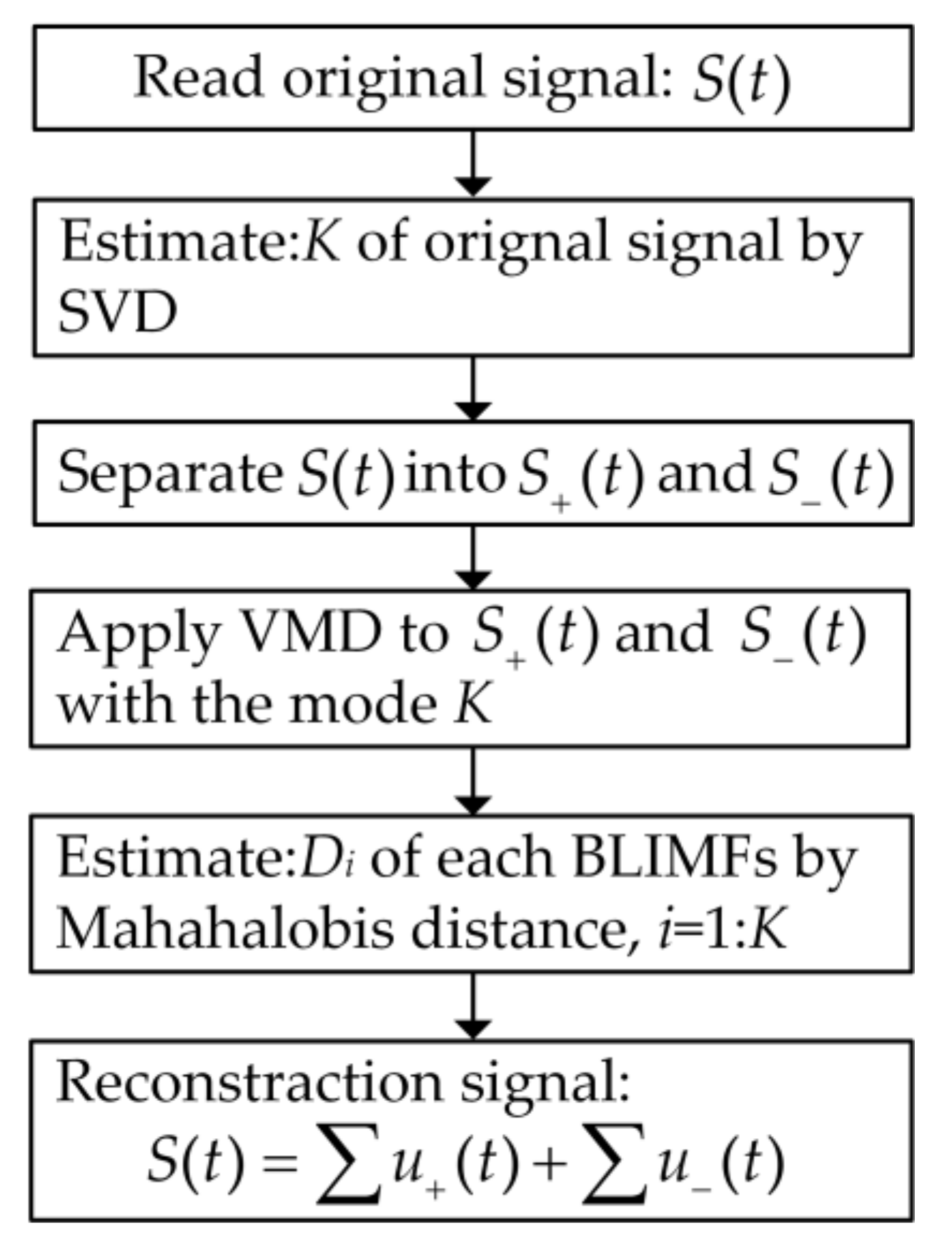


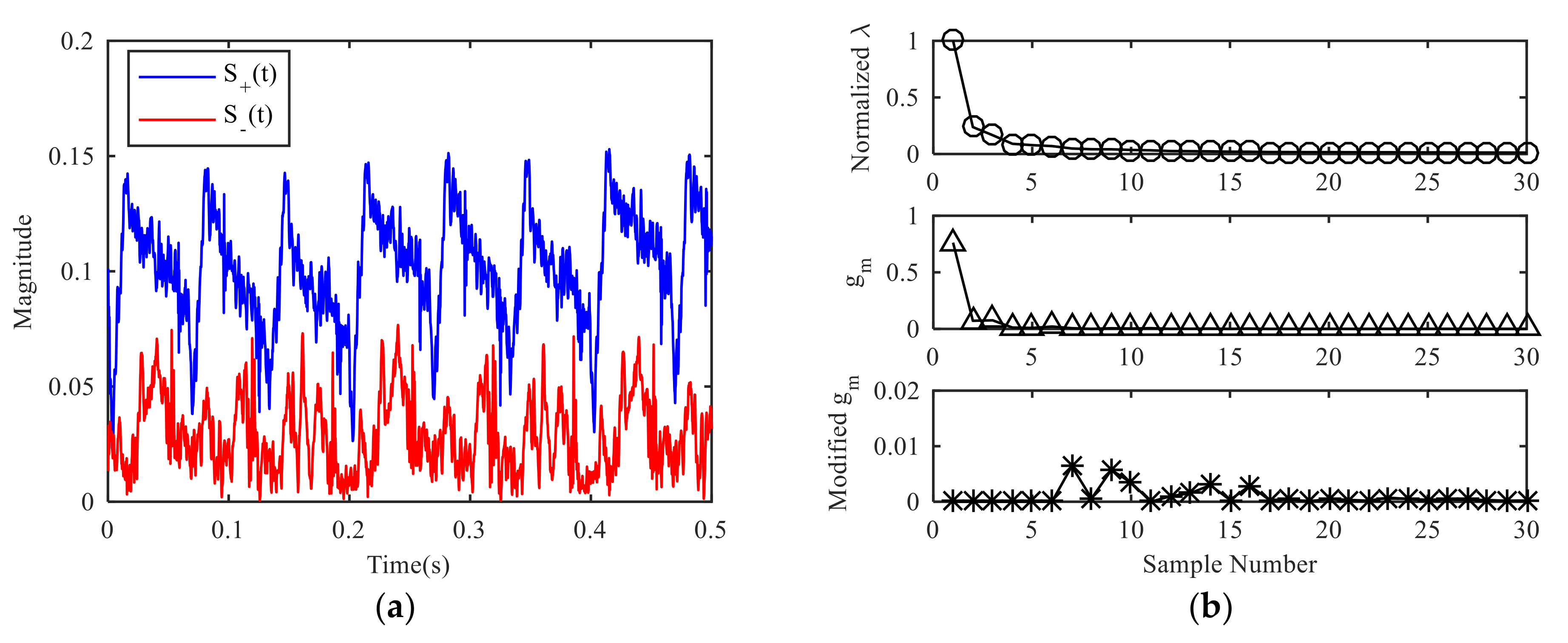


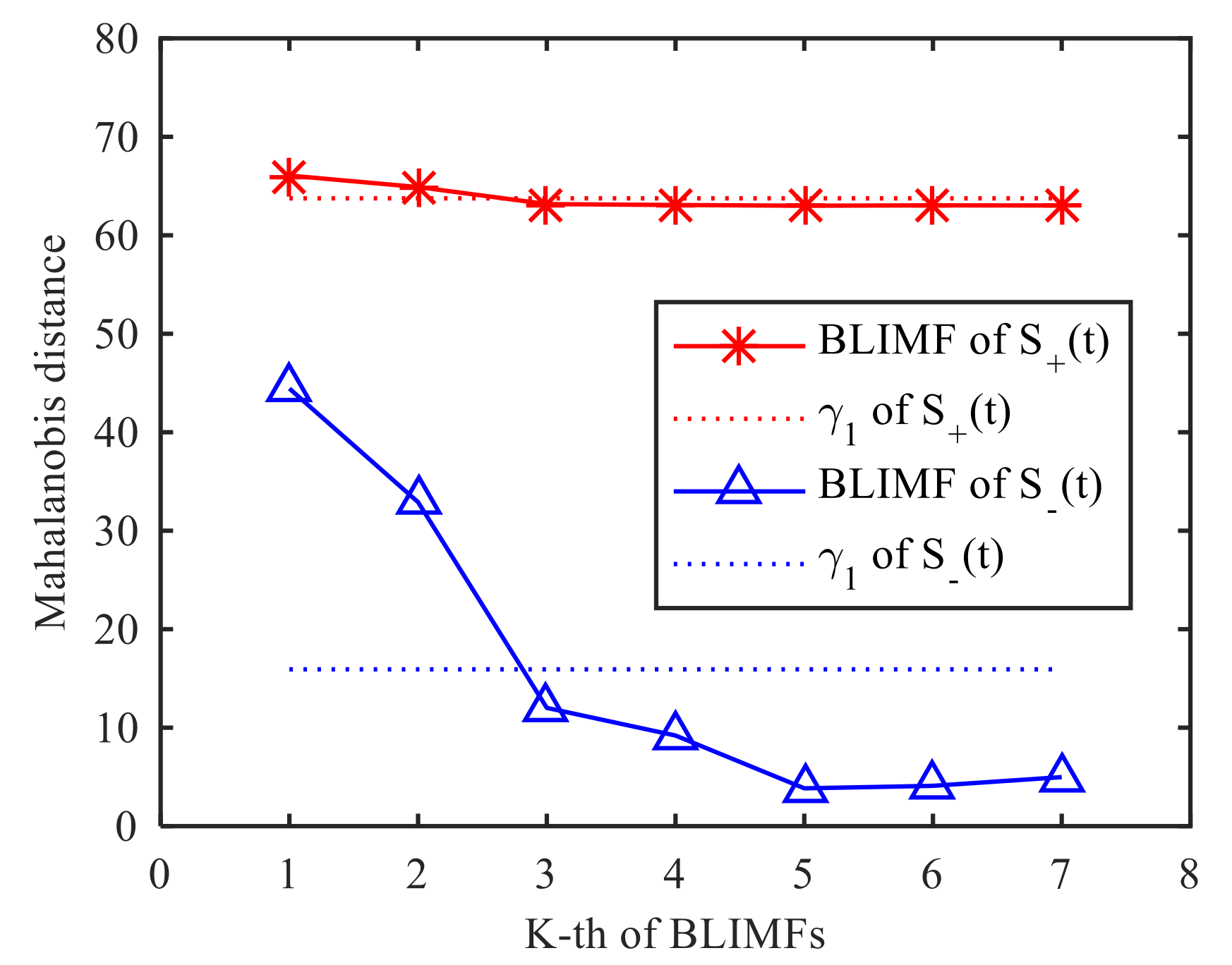
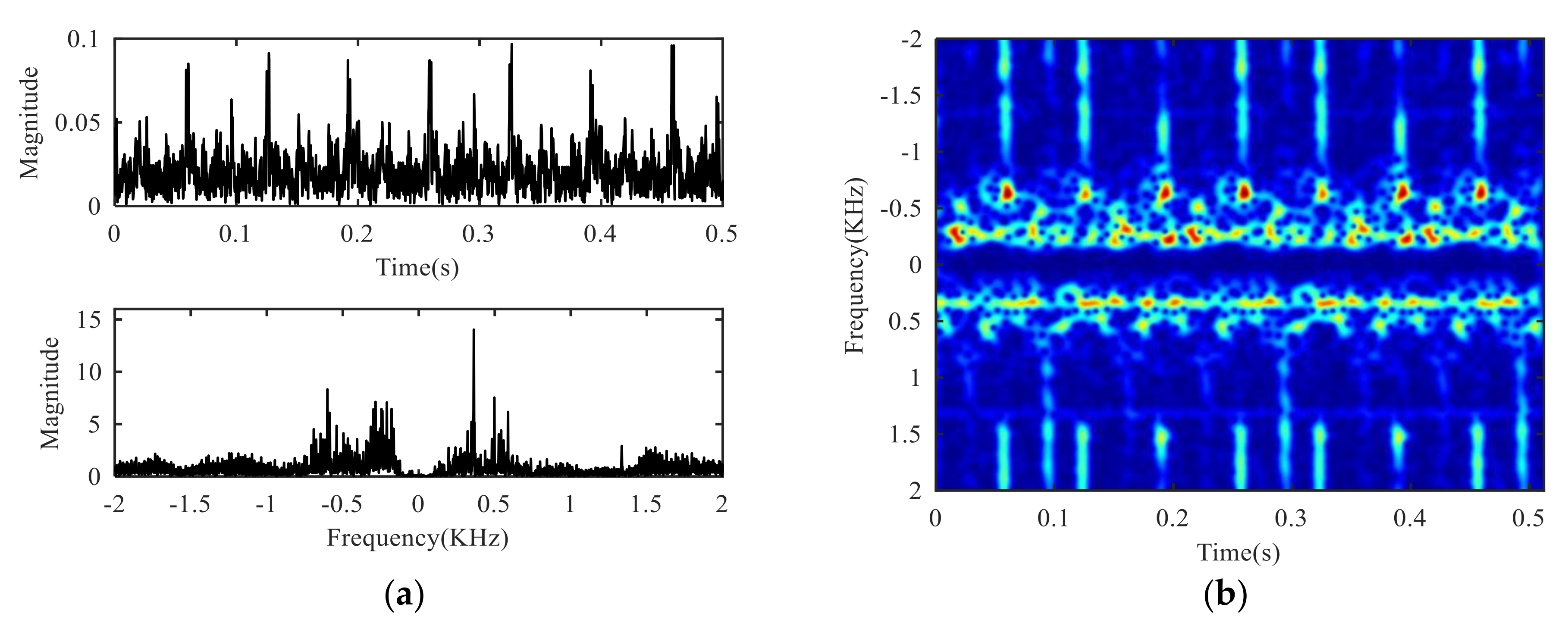
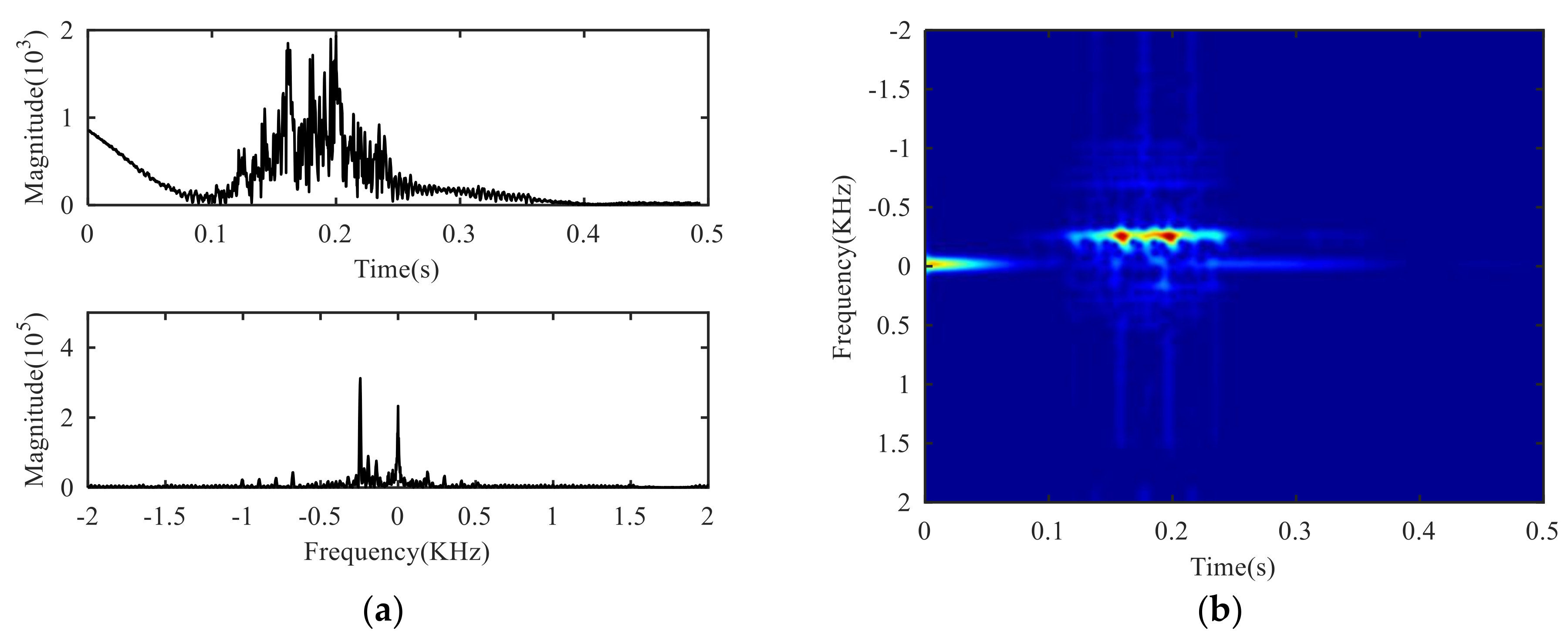
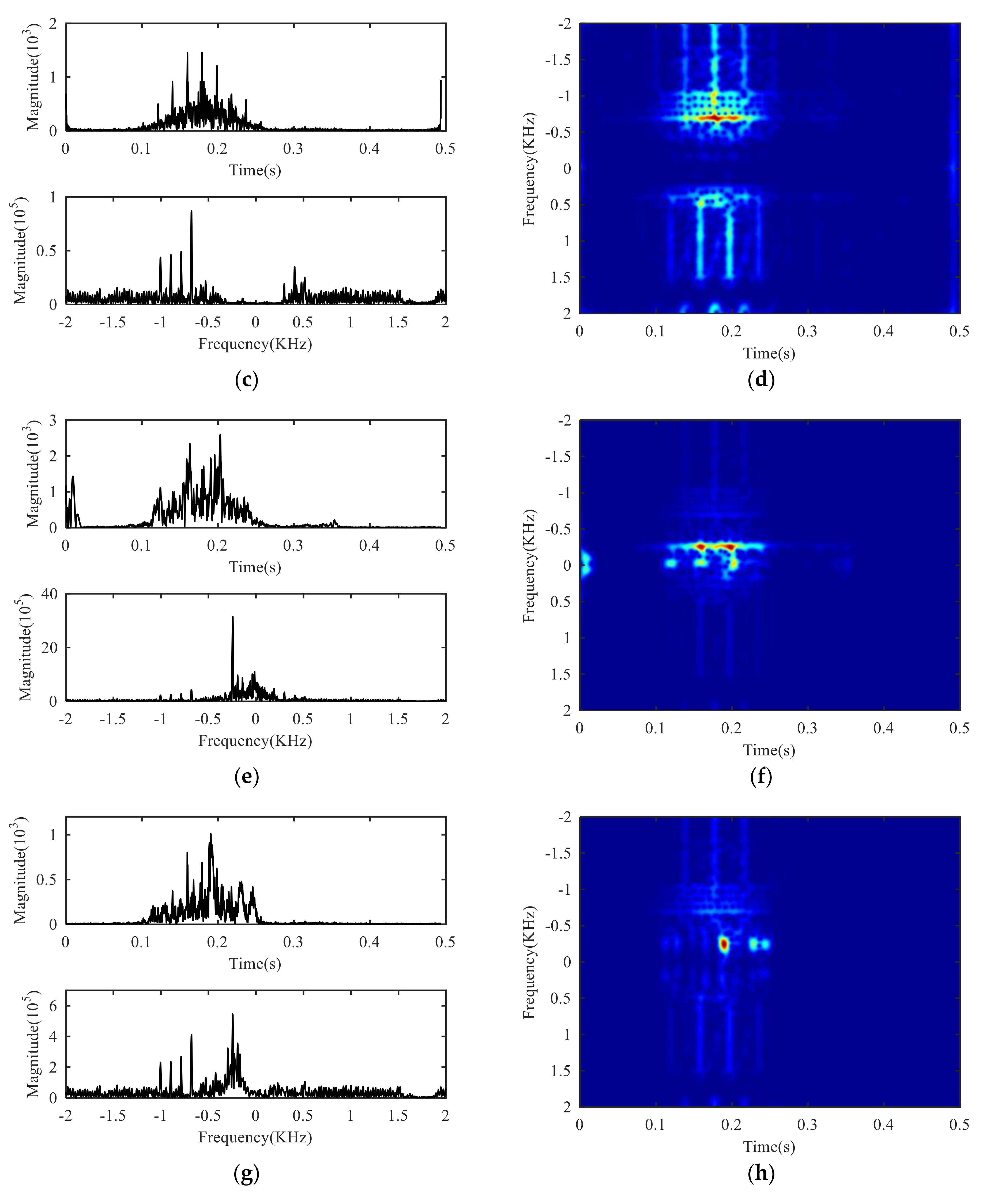


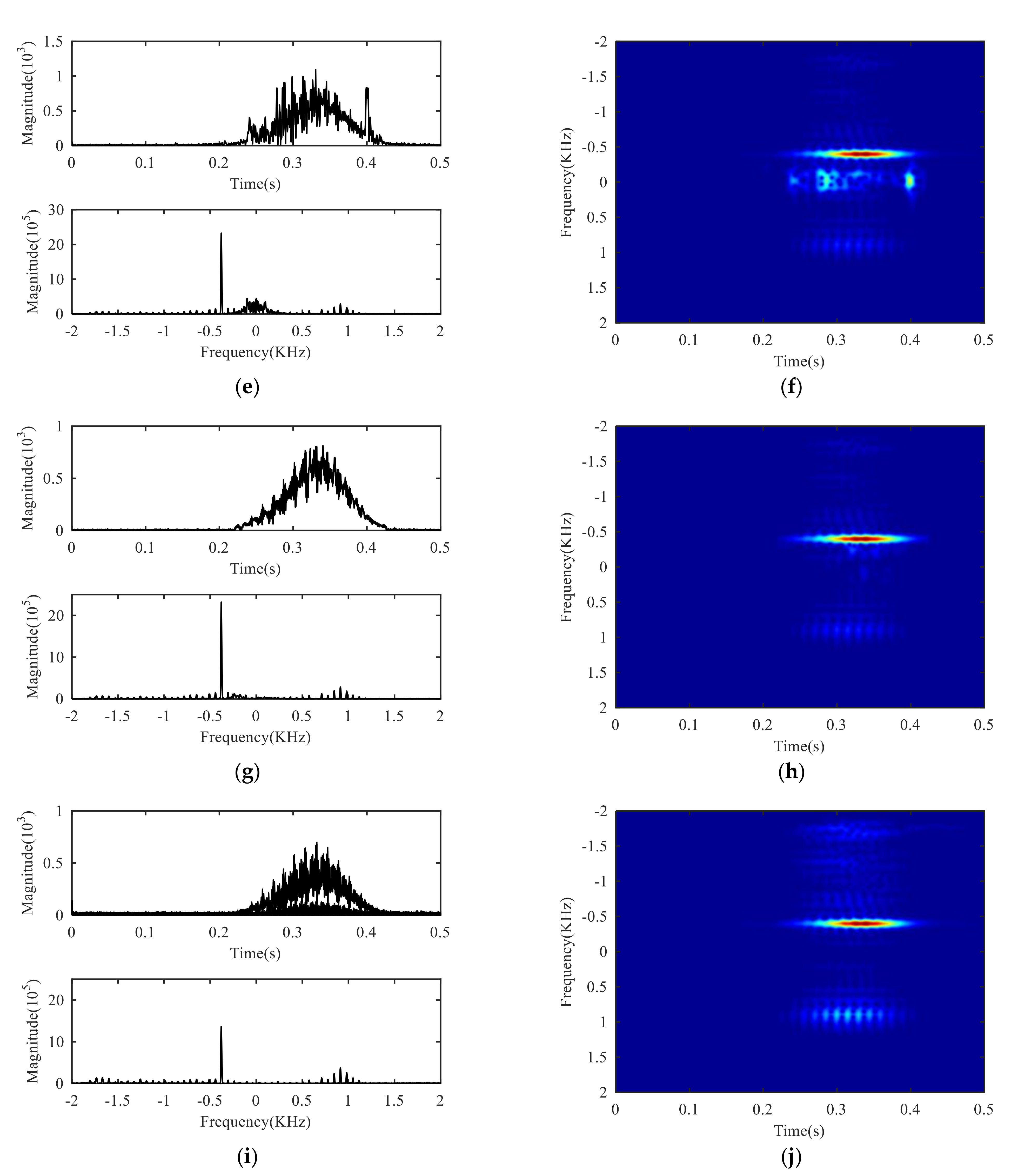
| SNR (dB) | −10 | −8 | −6 | −4 | −2 | 0 | 2 | 4 | 6 | 8 | 10 |
|---|---|---|---|---|---|---|---|---|---|---|---|
| DFA | 12 | 10 | 9 | 9 | 7 | 5 | 5 | 5 | 4 | 4 | 4 |
| EMD | 7 | 6 | 7 | 7 | 6 | 6 | 7 | 6 | 6 | 6 | 6 |
| SVD | 1 | 1 | 2 | 3 | 3 | 4 | 4 | 4 | 4 | 4 | 4 |
| CORR | BD | HD | ED | MD | ||||||
|---|---|---|---|---|---|---|---|---|---|---|
| BLIMF1 | 94.84 | 121.48 | 8.19 | 9.52 | 28.64 | 23.14 | 115.05 | 51.54 | 66.07 | 44.44 |
| BLIMF2 | 114.43 | 132.73 | 8.21 | 9.37 | 45.67 | 40.71 | 170.27 | 122.49 | 64.90 | 32.90 |
| BLIMF3 | 201.16 | 225.28 | 10.00 | 10.69 | 86.80 | 77.82 | 462.68 | 294.08 | 63.17 | 12.01 |
| BLIMF4 | 234.21 | 248.68 | 9.68 | 10.49 | 158.36 | 146.12 | 670.03 | 477.20 | 63.08 | 9.20 |
| BLIMF5 | 291.46 | 332.49 | 8.16 | 9.37 | 475.27 | 684.46 | 1290.7 | 1431.8 | 63.00 | 3.84 |
| BLIMF6 | 244.87 | 296.81 | 8.02 | 8.68 | 468.58 | 622.35 | 1095.9 | 1266.6 | 63.04 | 4.10 |
| BLIMF7 | 251.63 | 273.10 | 7.88 | 8.67 | 591.37 | 666.56 | 1231.1 | 1135.1 | 63.03 | 4.98 |
Publisher’s Note: MDPI stays neutral with regard to jurisdictional claims in published maps and institutional affiliations. |
© 2021 by the authors. Licensee MDPI, Basel, Switzerland. This article is an open access article distributed under the terms and conditions of the Creative Commons Attribution (CC BY) license (http://creativecommons.org/licenses/by/4.0/).
Share and Cite
Xia, S.; Yang, J.; Cai, W.; Zhang, C.; Hua, L.; Zhou, Z. Adaptive Complex Variational Mode Decomposition for Micro-Motion Signal Processing Applications. Sensors 2021, 21, 1637. https://doi.org/10.3390/s21051637
Xia S, Yang J, Cai W, Zhang C, Hua L, Zhou Z. Adaptive Complex Variational Mode Decomposition for Micro-Motion Signal Processing Applications. Sensors. 2021; 21(5):1637. https://doi.org/10.3390/s21051637
Chicago/Turabian StyleXia, Saiqiang, Jun Yang, Wanyong Cai, Chaowei Zhang, Liangfa Hua, and Zibo Zhou. 2021. "Adaptive Complex Variational Mode Decomposition for Micro-Motion Signal Processing Applications" Sensors 21, no. 5: 1637. https://doi.org/10.3390/s21051637
APA StyleXia, S., Yang, J., Cai, W., Zhang, C., Hua, L., & Zhou, Z. (2021). Adaptive Complex Variational Mode Decomposition for Micro-Motion Signal Processing Applications. Sensors, 21(5), 1637. https://doi.org/10.3390/s21051637






